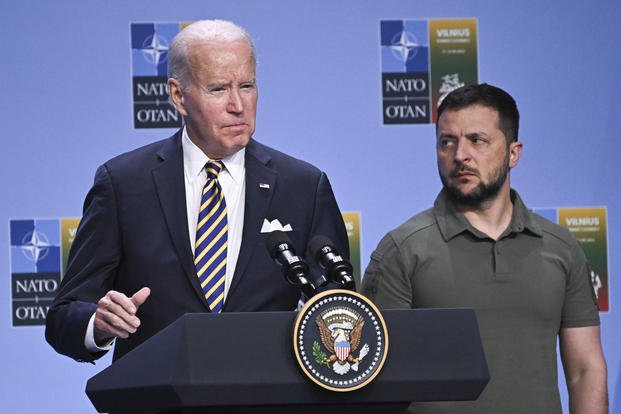

BRUSSELS (AP) — NATO leaders plan to pledge next week to keep pouring arms and ammunition into Ukraine at current levels for at least another year, hoping to reassure the war-ravaged country of their ongoing support and show Russian President Vladimir Putin that they will not walk away.
U.S. President Joe Biden and his counterparts meet in Washington for a three-day summit beginning Tuesday to mark the military alliance’s 75th anniversary as Russian troops press their advantage along Ukraine’s eastern front in the third year of the war.
Speaking to reporters on Friday, NATO Secretary-General Jens Stoltenberg said NATO’s 32 member countries have been spending around 40 billion euros ($43 billion) each year on military equipment for Ukraine since the war began in February 2022, and that this should be “a minimum baseline” going forward.
“I expect allies will decide at the summit to sustain this level within the next year,” Stoltenberg said. He said the amount would be shared among nations based on their economic growth, and that the leaders will review the figure when they meet again in 2025.
NATO is desperate to do more for Ukraine but is struggling to find new ways. Already, NATO allies provide 99% of the military support it gets. Soon, the alliance will manage equipment deliveries. But two red lines remain: no NATO membership until the war is over, and no NATO boots on the ground there.
At their last summit, NATO leaders agreed to fast-track Ukraine’s membership process — although the country is unlikely to join for many years — and set up a high-level body for emergency consultations. Several countries promised more military equipment.
A year on, they want to put on a fresh display of unity and resolve, even as uncertainty over elections roils many of the organization’s biggest members. The possible return of Donald Trump, who undermined trust among the allies while he was the U.S. president, is a particular concern.
But governments in France and Germany were also weakened in elections this year. Italy is led by a prime minister whose party has neo-fascist roots, while an anti-immigrant party heads a shaky coalition in the Netherlands and Spain’s Cabinet relies on small parties to rule. The U.K. will have a new leader.
Whoever might be in power though, it’s become clear that there’s not a lot more that NATO can do.
Lately, Stoltenberg has insisted on a long-term commitment to Ukraine. Major funding delays, notably due to political wrangling in the U.S. Congress, have left the country’s armed forces, in his words, “to defend themselves with one hand tied on the back.”
He had hoped the allies would agree to spend at least 40 billion euros annually on weapons in a “major, multi-year” program. It does not mean an increase in support, though. The figure roughly equals what they have already spent each year since the war began.
One new scheme the leaders are likely to endorse is a mission to get the right military equipment into Ukraine and streamline training for its armed forces. In their haste to help, Western backers have inundated Ukraine with all kinds of weapons and materiel.
In the early chaos of war, anything was welcome, but the deliveries have become unmanageable — a multitude of different kinds of vehicles or defense systems that require distinct maintenance plans and dedicated supply chains to keep them running.
Offers of training programs outside Ukraine have also been abundant, indeed so prolific and different that its armed forces struggle to prioritize which troops to send, to what NATO country, and for how long.
“We’ve let a thousand flowers bloom,” conceded a senior U.S. State Department official, but added that with a new mission, probably based in Wiesbaden, Germany, and under the likely leadership of a U.S. general, “NATO can come in and say: We’ve got it.”
The official requested anonymity to discuss plans that had not been finalized.
Sending military equipment via this new mission would also prevent rogue governments or leaders from meddling with joint deliveries. NATO officials say the mission would complement the U.S.-led effort to drum up arms, the so-called Ramstein group.
Another conundrum for the leaders is how to frame Ukraine’s membership prospects without letting it join. Many allies refuse to allow Ukraine in while fighting continues, concerned about being dragged into a wider war with Russia. Hungary opposes Ukraine’s membership altogether.
In the run-up to the summit, NATO envoys have been weighing the use of words such as “irreversible” to describe Ukraine’s path to membership as they tweak language that has shifted constantly since they promised in 2008 that the country would join one day.
It’s unclear how this will be accepted in Kyiv. At their last meeting, the leaders were non-committal about timing, saying only that they would be “in a position to extend an invitation to Ukraine to join the alliance when allies agree and conditions are met.”
President Volodymyr Zelenskyy described it as “unprecedented and absurd when a time frame is set neither for the invitation nor for Ukraine’s membership.” He complained that “vague wording about ‘conditions’ is added even for inviting Ukraine.”
In recent weeks, Zelenskyy and other Ukrainian officials have been briefed on developments to avoid a repeat. Stoltenberg said he and Zelenskyy agreed earlier this month that the new steps the leaders will take “constitute a bridge to NATO membership and a very strong package for Ukraine at the summit.”
Membership would protect Ukraine against a giant neighbor that annexed its Crimean Peninsula a decade ago and more recently seized vast swaths of land in the east and south. Before then, Kyiv must reform its security institutions, improve governance and curb corruption.
© Copyright 2024 Associated Press. All rights reserved. This material may not be published, broadcast, rewritten or redistributed.
